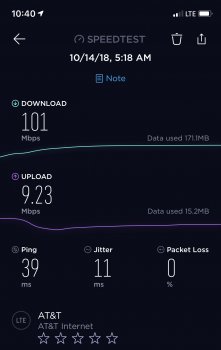What tests exactly? Do you know how to use Field Test on your phone? That's how to see the band. Here is a tutorial on how to use Field Test mode. Note that the tutorial focuses on seeing signal strength and not the band however. For the band, you must choose "Serving Cell Info".
http://osxdaily.com/2018/05/02/use-field-test-mode-iphone-x-ios/
After toggling Airplane mode, the phone usually starts out on the strongest band (i.e. Band 13 for Verizon). In my case, this is 3-4 bars. This band will yield the best signal strength but does not provide the fastest speeds or best capacity. Think of it as the equivalent of 2.4GHz WiFi.
After 30 seconds or so it switches to a weaker band (less signal strength but better speed & throughput). In Verizon's case this is typically band 2/4 (depends on what Verizon has in your area). With Verizon, it could also be band 5 or 66 (which is similar to band 4). When my phone is on band 4 in my apartment, I typically see 1-2 bars.
The weaker bands are similar to 5GHz WiFi networks. Better speeds and higher capacity but worse range. I understand why the phone prefers these bands. But, if the signal gets bad enough to effect quality, it should switch to the stronger band. Most times, it does not. It would rather drop a call vs. switch to band 13 in the case of Verizon.
That said, I've seen this behaviour to some degree for years. It may be worse on the XS however. Or the XS simply doesn't do as well with a crappy signal and needs to switch bands a bit sooner than previous iPhones. I'm not sure. But making the phone a tad more aggressive/eager to switch bands certainly wouldn't hurt once the signal reaches a certain threshold.
Here's another example of why the iPhone has issues with band selection (not exclusive to the XS)...
Verizon offers an LTE Network Extender. Basically a mini cell tower for your house which plugs into your router. By default it broadcasts on band 13.
iPhones do not like band 13. In many instances, an iPhone will NEVER connect to the LTE Network Extender if you don't toggle airplane mode upon returning home. It should gracefully connect since you've got a tower in your house with a strong signal. Yet, upon returning home, many times the iPhone will happily sit with 1 bar of band 4 from the cell tower for hours and never connect to the Network Extender. Basically, the phone never looks for alternative options if the band 4 signal is above a certain point and it will only connect to band 13 as an absolute last resort.
Verizon Network Engineers can change the Network Extender to broadcast on band 4 (vs. band 13) if Verizon holds a license to operate on band 4 in the area you live (most areas have band 4 licenses but maybe not all). Once they do this, the problem is solved. The iPhone will then connect to the Network Extender within 30 seconds of returning home without fail. Verizon Network Engineers have informed me that they do not have this issue with Samsung devices (I asked when I was on the phone with a very helpful engineer) and that only iPhones seem to be reluctant to connect the Network Extender.
So yes, SOME of these issues could be fixed with software should Apple choose to do so. But some of them are also longstanding issues IMO (as an iPhone user from the very beginning).


